Description of the physical characteristics of livestock breeds is very important for developing a breeding strategy in a particular production system. Doyogena sheep are among the potential breeds of Ethiopia reared in the mixed perennial crop and livestock production system of Southern Ethiopia. This research was conducted to characterise the morphological features of Doyogena sheep in an attempt to develop a breeding strategy that suits the production system of the area. A total of 512 sheep were characterized for different morphological features. Most (74.6%) of the sheep in the flock were females and 34.4% were old sheep of four and above dentition classes. Light red and red coat colour was abundant (71.5%) and 74% of the colour pattern was plain. Doyogena sheep are long fat-tailed (100%) and short haired (93.4%). The overall least square mean body weight was 31.64±0.43 kg and was affected by sex and age of sheep. The mean heart girth (74.08±0.39 cm), body length (58.84±0.30 cm), and height at rump (69.71±0.29 cm) were also affected by sex and dentition. Positive and significant correlations were obtained between body weight and other linear body measurements. The highest correlation coefficient was between body weight and heart girth. The positive and significant correlation of weight with linear body measurements indicate that linear body measurements can be used as a marker to estimate weight for different purposes. Different models can be used for different purposes. For simplicity, models with one variable can be used for marketing and by farmers. For breeding and selection purposes, since there is a need to be more precise, use of models involving more number of variables is important.
Ethiopia is endowed with 26 million heads of sheep (CSA, 2008)which are identified into nine breeds (Gizaw et al., 2007)and maintained in different agro-ecological zones. Sheep production is among the most important agricultural activities in the mixed perennial crop (Enset; Ensete ventricosum) and livestock production system of Southern Ethiopia providing cash income from the sale of live animals, as an insurance during crop failure, source of meat, and manure (Kocho, 2007).
Doyogena sheep, characterized as Adilo sheep (Gizaw et al., 2007), is a breed of sheep reared in the wet highlands of Doyogena district of Southern Nations Nationalities and Peoples Regional (SNNPR) state. It is kept by Wolayta, Kembata and Hadya peoples in the region. This sheep breed is grouped in the long fat-tailed sheep. Doyogena sheep is among the potential breeds of the country with better market preferences in the local market and nearby markets like Shashemene and Addis Ababa markets (Kocho, 2007). However, like other breeds of Ethiopia (ESGPIP, 2008; Getachew et al., 2010; Taye et al., 2010), the productivity level is below its genetic potential due to low level of management, high incidence of disease and lack of knowledge of farmers to use appropriate breeding strategy that is suitable for the production system under which the breed is kept. It is very important for the physical body characteristics of the breed to be described in order to develop a breeding strategy (Melesse et al., 2013a).
Information on the weight of sheep is important for different sheep management practices such as medication, marketing, breeding and sometimes for supplemental feeding. Under traditional farm conditions where access to a weighing scale is difficult, other easier options are mandatory. The most widely used methods for estimating the weight of sheep under farm conditions are using a regression equation developed from other linear body measurements for the breed/population of interest (Melesse et al., 2013b). This paper characterizes Doyogena sheep using morphological characteristics and established weight estimating regression models from linear body measurements in Doyogena district in an effort to develop a sheep breeding strategy.
1wet highland – altitude range of 3,200-2,300, Rain fall >1,400 mm, very high vegetation. Source: MoA 1998.
Ethical standards
The body measurements were taken after a consent from the local authorities (district office of Agriculture and Areka Agricultural Research Centre) and owners of the animals. No additional specific permissions were required from the Ethics Committee of the International Livestock Research Institute at the time of measuring of the animals. During body measurement, animals were handled properly.
Study areas
The study was conducted in Ancha, Serera and Awora peasant associations (PAs; the smallest administrative unit of Ethiopia) of Doyogena district which is found in Kembata Tembaro Zone of SNNPR state, Ethiopia. The district is situated at 258 km from Addis Ababa (national capital) and 171 km from Hawassa (the regional capital).
Doyogena district lies between 7°20’ N latitude and 37°50’ E longitude. It has altitude that ranges from 1900 to 2300 m above sea level (m asl). The mean annual rainfall is 1200 to 1600 mm, and the mean temperature varies between 10 and 16°C (Bureau of Agriculture (2012), unpublished). There are two rainy seasons. The main rainy season spans from June to September and a small shower falls from February to May. The mean land holding of the district is 0.75 hectares (Bassa, 2016). About 86% of the area is cropping land, 11.8% is covered with forest and bushes, 2% is grazing land and 0.2% is degraded land (Asmare et al., 2016). The major livestock species reared by the community include cattle, sheep and goat, equines, poultry, and honey bee. The major crops grown in the district include Enset, Faba bean, wheat, barley, field pea, vegetables and others (Asmare et al., 2016).
Sampling and data collection
The study areas were purposively selected; those PAs that are going to be involved in the sheep breeding strategy and development project were selected. In the study areas, 120 farmers involved in sheep production were randomly selected and their sheep were used for characterization. Morphological data were collected from sheep with an age (dentition was used to estimate age) of about nine months (0 pairs of permanent incisors (PPI) considered as yearlings) up to old age groups (gummy dentition groups), and from all sex groups in the flock. Accordingly, a total of 512 sheep were sampled and used for data collection. Both qualitative and quantitative linear body measurement data were collected as per the descriptor lists recommended by Food and Agriculture Organization (FAO, 1986).
Qualitative body characteristics collected include coat colour, coat colour pattern, hair type, head profile, presence/absence of wattle, presence/absence of toggle, presence/absence of horn, horn shape, horn orientation, ear orientation, tail type, and tail shape. Quantitative linear body measurements taken were: heart girth (HG), body length (BL), height at wither (HW), height at rump (HR), pelvic width (PW), ear length (EL), tail length (TL), tail circumference (TC), horn length (HL), and scrotal circumference (SC).
All the body measurements were taken using flexible metal tape (3-m length) to the nearest 0.5 cm precision after restraining and holding the animals in an unforced position. Body weight was taken using suspended Salter balance (50 kg capacity with 200 g precision).
Data analysis
Data collected from the field were entered, cleaned and analysed using Statistical Package for the Social Sciences (SPSS, 2008). Qualitative morphological characteristics were analysed using the frequency and descriptive statistical procedures of the package. The General Linear Model (GLM) procedures were used to estimate least squares means and standard errors of quantitative linear body measurements. Sex and dentition were considered as fixed effects for the analysis of quantitative traits. Dentition was classified (ESGPIP, 2008)as: (1) Yearlings, these are sheep with zero PPI, but estimated to be approximately above nine months of age; (2) 1 PPI, sheep with one PPI (sheep from about 1 to 2 years); (3) 2 PPI, sheep with two PPI; (4) 3 PPI, sheep with three PPI; ³4 PPI, sheep with four PPI and gummy.
The model used to analyse weight and linear body measurements was:
Yij = μ + Si +Tj + (ST)ij +eij
where Yij is the observation on body weight and other linear body measurements; μ is the overall mean; Si is the fixed effect of sex (i = Female, Male, Castrate); Tj is the fixed effect of dentition (j = 0, 1, 2, 3, >4); (ST)ij is the interaction effect of sex with dentition; eij is the effect of random error.
Effect of sex and the interaction between sex and dentition were not used for the analysis of scrotal circumference. Pearson’s correlation coefficient was estimated between body weight and other body measurements and each other using the correlation procedures of SPSS (SPSS, 2008). Linear body measurements were regressed on body weight to develop simple linear, multiple linear and quadratic regression equations that can estimate body weight. The stepwise elimination procedure was used to develop multiple linear regression equations.
The models used to develop weight prediction regression equations were:
Y = a + βX (Simple linear)
Y = a + β1X1 + β2X12 (Quadratic)
Y = a + β1X1 + β2X2 +….+ βnXn (Multiple linear)
where Y is the response variable, body weight; a is the intercept; β is the regression coefficient; X is the body measurements; and n is the nth number of body measurement.
Flock structure
Flock composition in terms of sex and age classes (presented in Table 1) is an important indicator of the management system and objective of sheep production (Ibrahim, 1998). About 34% of the animals on which body measurement data has been collected were sheep with 4 PPI and above, of which most of them were females (94.9%), followed by yearlings (27.3%), and 1 PPI (23.4%). With regard to the sex of animals, females were abundant (74.6%) followed by males (18.0%). Within males, yearlings were abundant than other age groups. The proportion of female sheep increases as age increases in the flock which indicates that females are retained for a long period for breeding purposes. Because castrates are maintained for a short period of time after castration, most of them were with one PPI and of yearling age. The male to female ratio found (1:4.15) is said to be safe for proper breeding which is 1:20 to 25 in a year-round breeding (ESGPIP, 2008).
Qualitative morphological traits
The qualitative morphological characteristics of Doyogena sheep is presented in Table 2. Figure 1 illustrates the common coat colour and physical features of Doyogena sheep preferred by the farmers. Most (56.1%) of the sheep had straight facial profile. Among sex groups, most of the males (82.6%) and castrates (71.1%) had concave facial profile while most of the females (68.10%) had a straight facial profile.
Light red and red coat colour was abundant (71.5%) in the population which accounted for 67.4 and 72.3% for males and females, respectively. Red and white mixed either as spotted or patchy coat colour pattern were the second most abundant coat colour types. Other colour types like plain white, plain black and/or mixed with any other colour and gray colours were rare. Plain coat colour pattern was dominant (74%) followed by the patchy one (21.5%). The coat colour types and coat colour pattern were almost similar among sex groups. This might be because coat colour type and pattern have been gotten due to attention by the community as selection criteria.
Most of the sheep (93.4%) were short haired; while a few (6.6%) were long haired. The tail type was long fat (100%) which is pendulous straight towards the ground (91.1%). About 96.7, 92.9 and 100% of the males, females and castrates had straight tail shape, respectively. Sheep with curled and twisted tail shape types were few. Tail shape and length are important selection criteria for ram selection in Doyogena sheep (Taye et al., 2012).
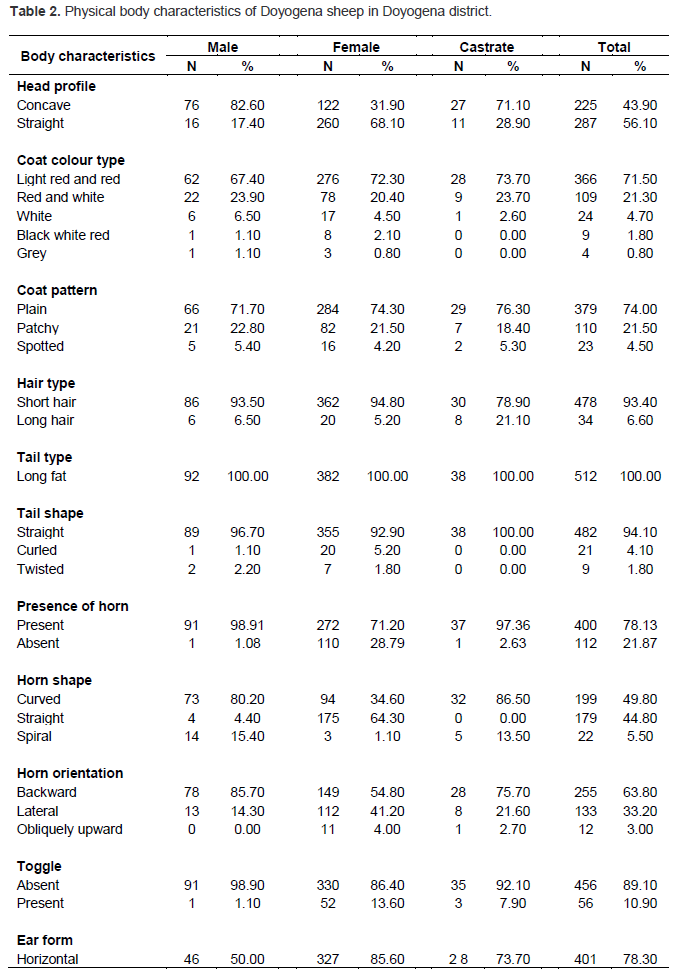

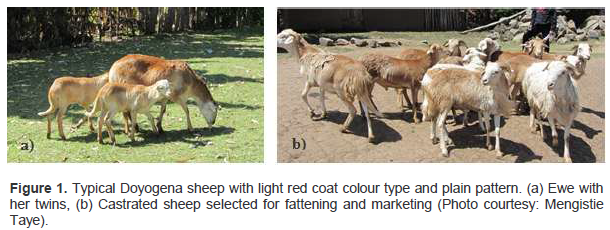
Horn is an important trait in Doyogena sheep. Farmers in Doyogena area believe that horned ewes produce more milk and therefore they can support better lamb growth. 78.13% of the sheep population were found horned. Most of the males (80.2%) and castrates (86.5%) had curved horns that are oriented backward (85.7% for males and 75.7% for castrates). Most (64.30%) of the females had straight horn shape with backward orientation (54.8%) and lateral orientation (41.2%). All the sheep sampled had no wattle and only 10.9% of them were with toggle. Farmers cull sheep with toggle using different mechanisms like castration and slaughter and select against the trait. This is because, they believe that sheep with toggle are not productive. Most (78.3%) of the sheep had horizontal ear form.
Quantitative physical body measurements
The mean and standard deviation of linear body measurements is presented in Table 3. There was a range of values for different traits which indicate the potential variation in the population for selection.

The least squares mean body weight obtained in the current study was 31.64±0.43 kg (Table 4). This value is comparable with Gumuz sheep (Abegaz et al., 2011), but larger than the value reported for other breeds listed in Table 5 (Kocho, 2007; Getachew et al., 2010; Bimerow et al., 2011; Melesse et al., 2013a). Body weight was significantly affected by the sex of sheep that females had a lower weight than males and castrates. Dentition also affected body weight of sheep. Yearlings had a lower weight than other higher dentition groups, and this might be because of the fact that yearlings has not yet achieve mature body weight as depicted by the growth curve in Figure 2. The interaction effect of sex and dentition was also significant (p<0.001). A significant effect of sex and age of sheep on body weight of sheep is reported by many scholars for different breeds of sheep (Edea et al., 2010; Getachew et al., 2010; Bimerow et al., 2011; Mavule et al., 2013).
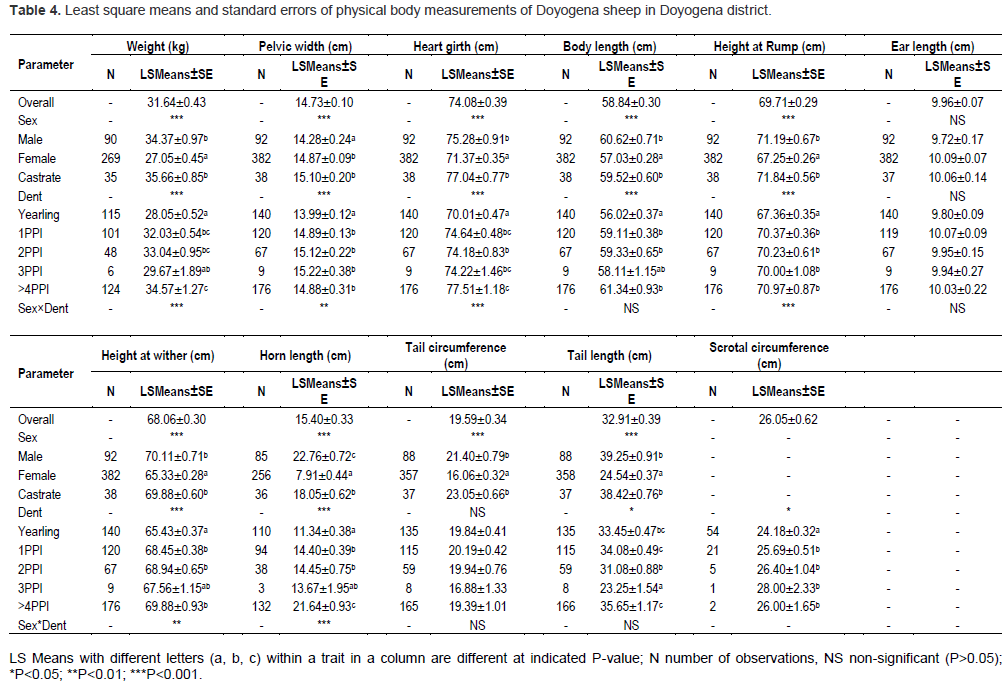
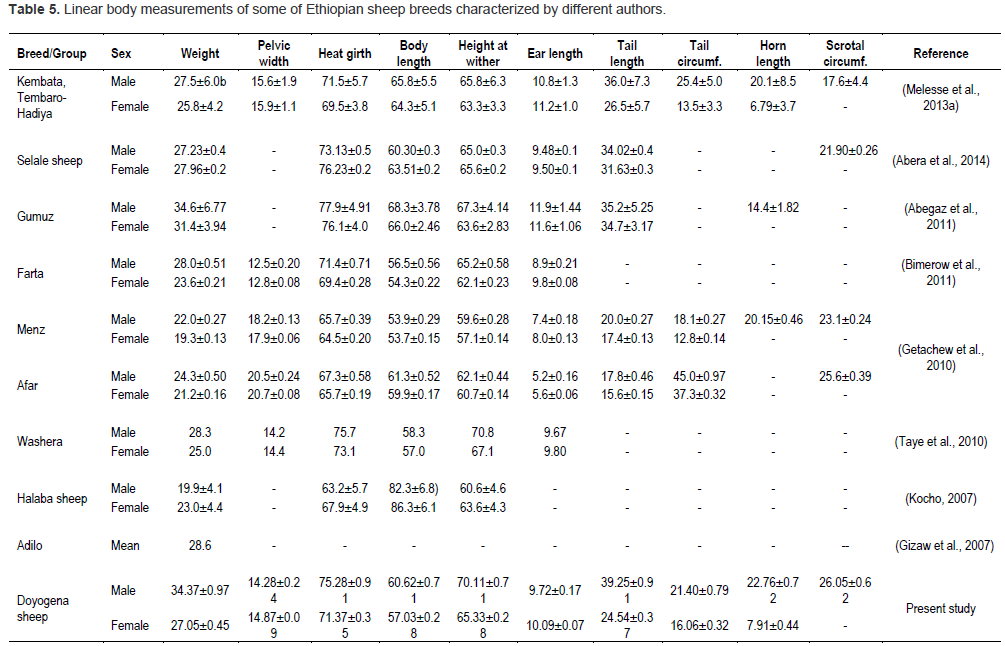
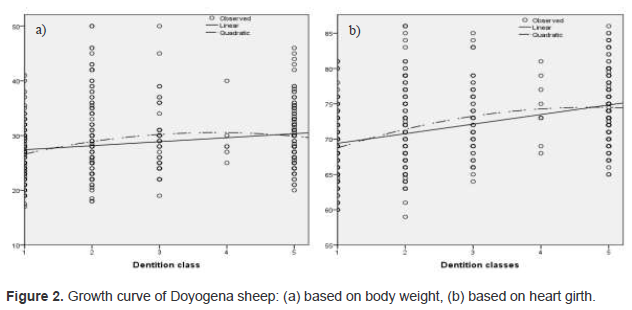
The overall mean pelvic width obtained (14.73±0.10) is similar to the value reported for Washera sheep (Taye et al., 2010). However, it is higher than Farta sheep (Bimerow et al., 2011)and lower than Menz and Afar sheep (Getachew et al., 2010), and sheep in Kembata, Tembaro-Hadiya areas (Melesse et al., 2013a). Pelvic width was affected (p<0.001) by both sex and age of sheep. The interaction was also significant (p<0.01) implying the importance of the trait for different age and sex groups. Yearling male sheep and young and old female sheep had a narrower (p<0.015) pelvis. Pelvic width is an important trait affecting the productivity of the ewe through its effect on ease of lambing, perinatal ewe and lamb mortality rates, and lifetime rearing performances (Van Rooyen et al., 2012). Body condition, evaluated from touching the pelvic, showed a significant effect on lambs born per ewe and reproductive performances (Aliyari et al., 2012). A similar effect of sex and dentition on the pelvic width of sheep is reported in the literature (Getachew et al., 2010; Taye et al., 2010).
The least squares mean of heart girth, body length, height at rump, and height at wither of Doyogena sheep obtained in the current study were 74.08±0.39, 58.84±0.30, 69.71±0.29, and 68.06±0.30 cm, respectively. Sex and age of sheep had a significant effect (p<0.001) on heart girth, body length, height at rump, and height at withers that females and yearlings had lower values in all the traits. The interaction effect of sex and age (dentition) was significant (p<0.01) for heart girth, height at rump, and height at wither however, it did not affect the body length.
Doyogena sheep had similar heart girth with Washera Farta, and Gumuz sheep (Taye et al., 2010; Abegaz et al., 2011; Bimerow et al., 2011), but higher than Menz and Afar sheep (Getachew et al., 2010), and Halaba sheep (Kocho, 2007). Doyogena sheep has longer body length than Menz sheep (Getachew et al., 2010)and shorter body length than Gumuz (Abegaz et al., 2011)and Halaba sheep (Kocho, 2007). It has similar body length with Washera, Farta, and Afar sheep breeds (Getachew et al., 2010; Taye et al., 2010; Bimerow et al., 2011). The height at wither obtained was similar with Washera sheep (Taye et al., 2010), however, Doyogena sheep is taller than Menz and Afar (Getachew et al., 2010), Farta (Bimerow et al., 2011), and Halaba sheep (Kocho, 2007). In most of the traits considered, Doyogena sheep is better than other highland breeds of the country while it is comparable with sheep breeds known for their productivity in Ethiopia (Gizaw et al., 2007; Taye et al., 2010).
Horn length is an important trait in Doyogena sheep. The overall mean horn length (15.40±0.33 cm), analysed among those with horn, was significantly affected (p<0.001) by sex and age of sheep. Male sheep had longer horn followed by castrates. Horn length increased as the age of sheep increased. Tail length and tail circumference are important traits used as selection criteria especially for male sheep in the study area. The mean tail length (32.91±0.39) and circumference (19.59±0.34) obtained was larger than Menz sheep (Getachew et al., 2010), and Kembata, Tembaro-Hadiya (Melesse et al., 2013a). Tail length was similar with Gumuz sheep (Abegaz et al., 2011), and the circumference was narrower than Afar sheep (Getachew et al., 2010). Tail length and circumference of Doyogena sheep were affected (p<0.001) by sex of sheep. Females had short and narrow tail length and circumference, respectively. This might be because of the docking practice of farmers on female sheep and the selection practice towards longer and wider tail length and circumference of male sheep, respectively. Getachew et al. (2010) reported a similar effect of sex on tail circumference and length.
The mean scrotal circumference found in the current study (26.05±0.62 cm) was almost similar with Menz, Afar and Gumuz sheep (Getachew et al., 2010; Abegaz et al., 2011), and greater than sheep in Selale area (Abera et al., 2014). The effect of breed on the scrotal circumference is reported in the literature (Kridli et al., 2006). Scrotal circumference was affected by age of rams; yearlings had a smaller circumference than other higher age group sheep which were similar. Scrotal circumference is an indirect measure of the breeding performance of rams. Rams within a breed at a given age having larger scrotal circumference are likely to produce better quality and quantity of semen and reproductive success (ESGPIP, 2008). Rams with larger testicles also tend to sire ewe lambs that reach puberty at a younger age (http://www.sheep101.info/201/ramrepro.html).
From the growth curve, estimated using body weight and heart girth fitted against dentition classes (Figure 2), it is possible to understand that Doyogena sheep do not achieve mature weight until it erupts two PPI (3rd dentition group in the curve). Heart girth continued growing up to old age; indicates that different body parts mature at different ages (Mavule et al., 2013). Both body weight and heart girth showed a decline at the fifth dentition group which might be because animals after this age group are old, and therefore starts to lose weight. It is important to consider culling of sheep after they start to lose weight because of age.
Correlation and regression
The Pearson's correlation of linear body measurements with weight and with each other is presented in Table 6. There was a positive and significant (r>0.45; p<0.05) correlation between weight and other body measurements except with ear length. The highest correlation coefficient obtained was between body weight and heart girth (r = 0.86) which was followed by weight with height at rump (r = 0.74). The higher correlation of linear body measurements with body weight indicates that these linear body measurements can be used as indirect selection criteria in the absence of weighing scale (Khan et al., 2006). The observed positive (p<0.05) correlations between weight and other body measurements is in agreement with literature (Afolayan et al., 2006; Khan et al., 2006; Sowande and Sobola, 2008; Melesse et al., 2013b). The correlation of ear length with body weight was not significant. Similar non-significant correlation of ear length with body weight is reported elsewhere (Mavule et al., 2013). The non- significant effect of ear length with body weight might be because ear length is determined by non-additive genetic effects and less affected by the environment (Mavule et al., 2013). Therefore, use of ear length as a phenotypic marker to improve body weight in breeding programs will bring no value (Mavule et al., 2013).


Regression equations used to estimate the weight of animals from other easily measured linear body measurements is very important in selection and marketing of animals. Different regression models have been developed with different level of complexity to give users an option to use for different purposes as medication, marketing, and selection for a replacement stock (Otoikhian et al., 2008; Sowande and Sobola, 2008). The models are presented in Figure 3 and Table 7.


Regression equations were fitted for the male, castrate, female and pooled data that estimated weight with a precision of 75.4 to 100%. The highest coefficient of determination was depicted for female sheep (100%). Unlike other similar findings (Alex et al., 2010; Taye et al., 2010), heart girth was not the best variable to estimate body weight for female sheep. It was the height at rump and body length that were used to estimate weight for female sheep. In the pooled data, heart girth alone explained 96.8% of the variation in the body weight of sheep. The result is generally in agreement with literature (Thiruvenkadan, 2005; Alex et al., 2010; Taye et al., 2010)that heart girth is the best predictor of weight. Multiple regression models estimated weight with better accuracy; and accuracy of prediction increased with the increased number of variables (Taye et al., 2012; Melesse et al., 2013b). Therefore, choice of the equations should be based on the accuracy needed and level of difficulty at field conditions. Regression equations with a number of variables can be used in breeding programs while those simpler ones can be used for marketing and medication purposes.
Development and use of regression equations to estimate weight from linear body measurements requires due care not to bias the measurement due to the posture of the animal. With this respect, heart girth is the least affected by the posture of the animal during measure-ment. In addition, computation and use of equations developed from three and above traits is difficult. At field condition, use of heart girth is encouraged for the above reasons.
Doyogena sheep is among the sheep breeds reared in the Enset-crop-livestock production system of the SNNPR state, Ethiopia. The breed has attractive morphological features with a great potential for fattening. As compared to other local breeds of the country, Doyogena sheep is better in most of the morphological characteristics. The range of values in different traits considered in the population indicates its potential response to selection. The positive and significant correlation of weight with linear body measurements indicate that linear body measurements can be used as a marker to estimate weight using regression equations. Different models can be used for different purposes. For simplicity, models with a single variable can be used for marketing and by farmers. For breeding purposes, since there is a need to be more precise, use of models involving a number of variables is encouraged.